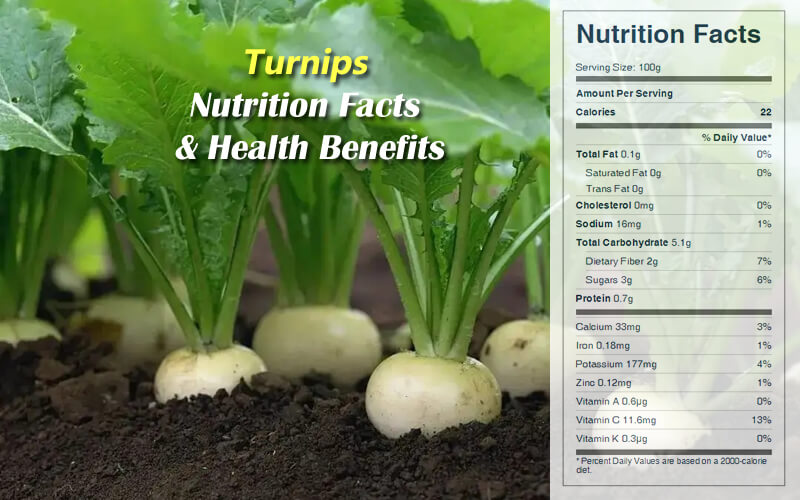Turnips Nutrition Facts & Health Benefits
Turnips are a functional food that has been found to protect the liver and support the gut. Turnip green, raw and cooked turnips have their benefits, they contain an abundance of plant-based phytonutrients, here are nutrition facts & health benefits of turnips.
Turnips are one of the oldest of all the cultivated vegetables, and have been a staple of the peasant diet in cold, northern European countries for many centuries. Turnips were an important crop in the cuisine of Antebellum America. They were grown for their greens as well as the roots, and could yield edible greens within a few weeks of planting, making them a staple of new plantations still in the process of becoming productive.
Boiled turnip is 94% water, 5% carbohydrates, and 1% protein, with negligible fat. They supply plenty of energygiving carbohydrates, along with reasonable amounts of many nutrients, including vitamins C and B6.

Turnip Nutrition Facts Label
Health Benefits of Turnips
There are more than thirty-five flavonoids found in turnips with some found in high concentrations in the outer layer of the skin. To benefit from these flavonoids, don't peel your turnips!
Turnips are warmly recommended for gout in traditional medicine, since they are eliminators of uric acid.
A thin purée of turnips, cooked in milk, is an old country remedy for bronchitis: the sulfurous compound raphanol may be responsible for this bactericidal action.
Turnips help protect the liver because they contain anthocyanins and sulfur compounds. Isorhamnetin-3-O-glucoside is a well-known flavonoid found in turnip root; it was found in animal studies to suppress liver enzymes AST and ALT. Additionally, the anti-inflammatory properties are attributed to arvelexin, a compound that works to reduces serum levels of nitric oxide and inflammatory cytokines.
The key health-promoting compounds found in turnips are glucosinolates and isothiocyanates. Glucosinolates (GLS) are nitrogen and sulfur metabolites primarily found in the Brassicaceae family of vegetables. If you consume them raw, the GLSs are broken down at the beginning of the intestinal tract by the plant enzyme myrosinase. If they are cooked with heat before consumption, the myrosinase becomes inactive and the GLS are partially absorbed in the stomach but then go into the colon and are consumed by the intestinal microbiome.
The best way to cook turnips is to steam them to preserve the glucosinolates. Glucosinolates have properties to prevent and treat diseases via their antioxidant, anti-inflammatory, chemoprotective, and anticancer activities.
Health Tips
In addition to the benefits of the actual turnip tops, the turnip leaves possess key antioxidant capabilities. The tops or turnip greens are as healthy as the turnips themselves, and are best when eaten young and fresh.
Most baby turnips can be eaten whole, including their leaves. Baby turnips are sold in yellow, orange, and red-fleshed varieties, as well as white-fleshed. Their flavor is mild, so they can be eaten raw in salads like radishes and other vegetables.